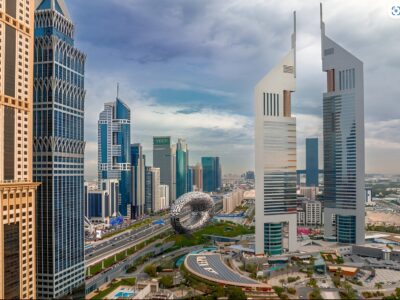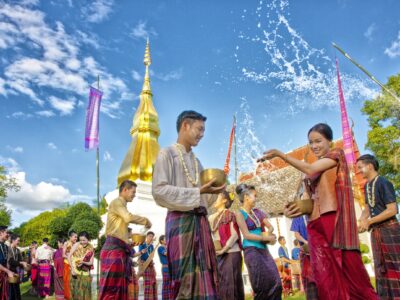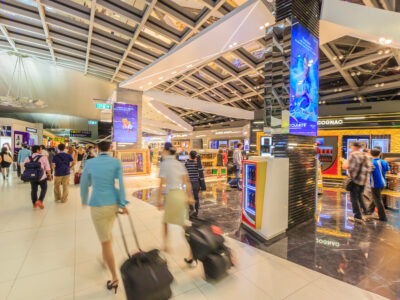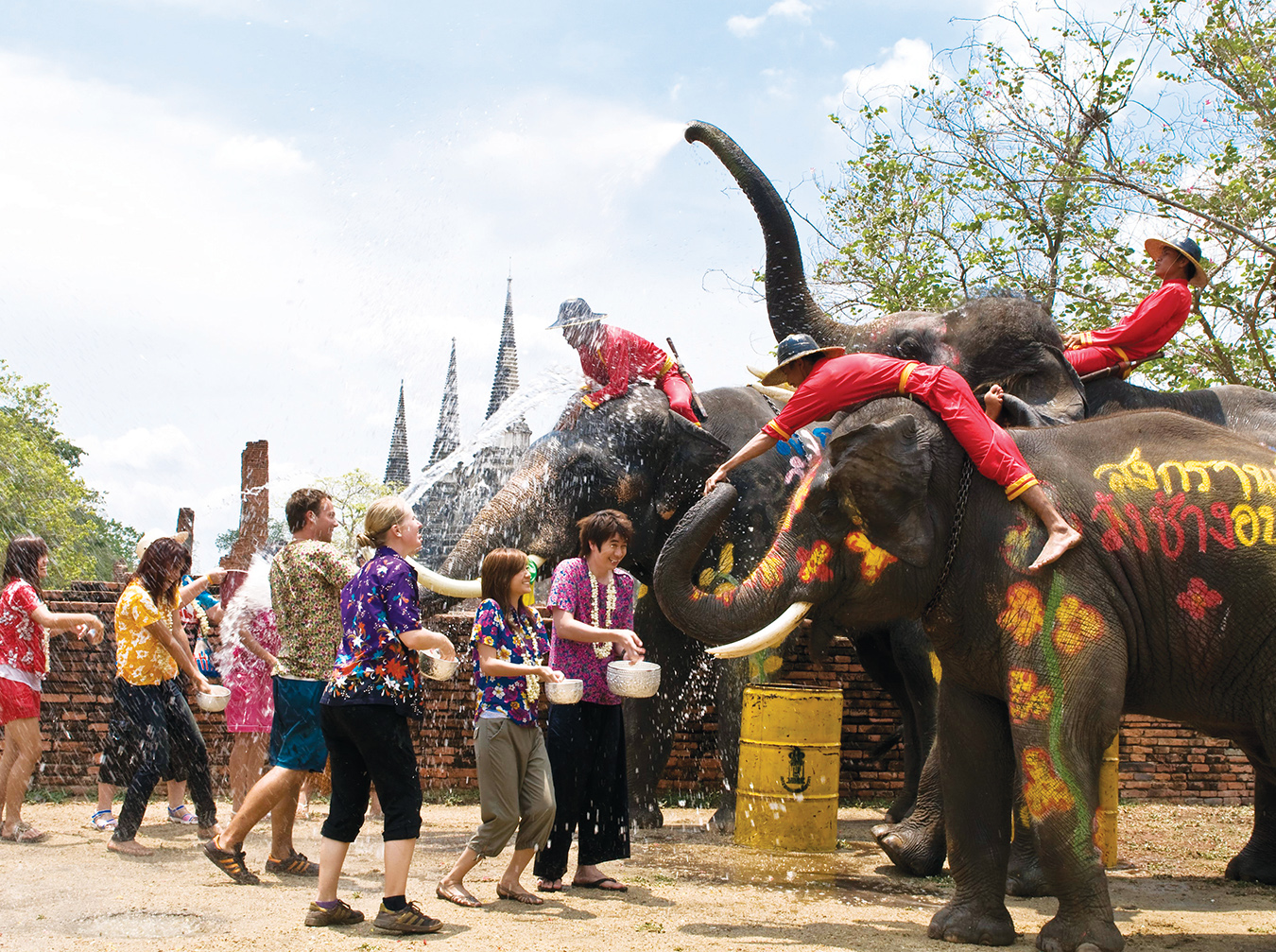
Tourists also engage in friendly water battles with the locals in the spirit of Songkran
Songkran is one of the most important festivals of Thailand, celebrated each year from April 13 to 15. The key Buddhist festival marks the beginning of the traditional Thai New Year. The word Songkran has its roots in the Sanskrit word Sankranti and means ‘passing’ or ‘approaching’. Astrologically, it coincides with the rising of Aries into Taurus, in accord with many other calendars of South and South-East Asia.
“Songkran is one of Thailand’s biggest festivals that the Thai celebratenation wide with great enthusiasm and joy. The festival highlights the grand celebration that attracts many international travellers to visit Thailand and join the locals to celebrate the festivity. Songkran is also a celebration of Thai traditional New Year which we share with our neighbouring countries Laos, Cambodia, Myanmar and also the area of North East India such as Arunachal Pradesh and parts of Assam, that celebrate Sangken festival, as the traditional New Year’s Day,” Vachirachai Sirisumpan, director, Tourism Authority of Thailand (TAT), New Delhi tells India Outbound.
“For most international travellers including Indian tourists, Songkran appeals as a Fun Fest of water throwing and enjoying a good time with friends and family. However, that is only one aspect of Songkran as it is also a time to celebrate and appreciate cultural and traditional aspects of Thailand,” explains Sirisumpan.
Myths and legends
Like many other festivals celebrated around the world, Songkran has its origins in myths and legends. The story revolves around the Hindu God Brahma, the creator of the universe.
The god is known as Kabila Phrom in Thailand and it is said He enjoyed betting and one day He met a seven-year-old boy prince. The prince, Thammabal Kumara, was said to be prodigious in learning, being able to recite scriptures in public and even understanding the language of birds. Kabila Phrom wanted to test the prince’s knowledge so He descended to the Earth and presented three riddles to the child.
Along with the riddles He presented a condition, should Thammabal answer the riddles correctly, then Kabila Phrom would offer His head to the prince. However, if the prince failed to find the right answers within seven days, he would lose his own head to Kabila Phrom. With this condition, Phrom presented the riddles: ‘One, where does a person’s aura exist in the morning? Two, where is a person’s aura at noon? Three, where does it appear at night?’
For six days the boy struggled to find the answer to the riddles. On the seventh day, while lying under palm trees, he heard an eagle couple cheerfully talking about how they would soon be able to feast on the prince’s dead body. Not knowing that he possessed the ability to understand the language of birds, the eagles revealed the answers to him. He immediately went to Kabila Phrom with the answers.
“In the morning, a person’s aura appeared on his face, so he washed it. At noon, it was at his chest; so, he wore perfume there. And at night, his aura moved to his feet; that was why he bathed them”, he told Kabila Phrom.
Kabila Phrom had lost his bet and cut off His own head. Kabila Phrom’s head, however, was enchanted. It was extremely hot, so if it should touch the ground, the earth would be engulfed in a firestorm, destroying all life; if it was dropped in the sea, the sea would dry up. If it was left in the air, there will be no rain, bringing upon a vast drought.
To save the world from these disasters and ultimate death, God’s seven daughters aka Nang Songkran, placed their father’s head on a phan or tray and carried it in procession around Mount Meru before placing it in a cave on Mount Kailash with a multitude of offerings. Thus, at the beginning of each year, Nang Songkran would take turns to bring out the God’s head and carry it in a procession around Mount Meru. This celebration is known as Songkran.
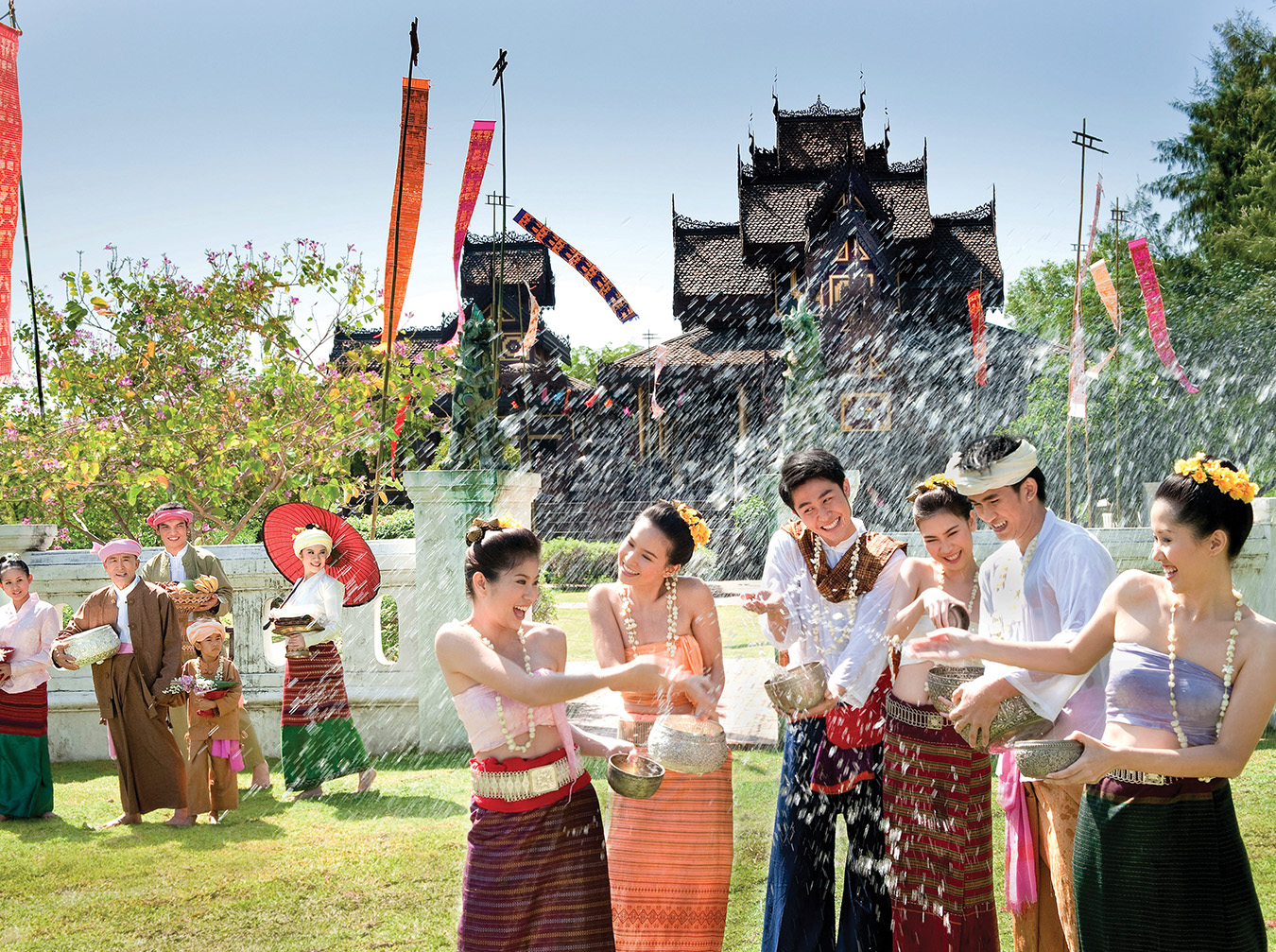
People of all ages engage in friendly water battles all across Thailand
Traditions of Songkran
Before the celebrations, people clean their homes and with the onset of Songkran many Thais begin their morning with ‘Making Merit’, one of the key parts of the festival. As part of the tradition, many people visit the local temples and offer food and other materials to monks. The offerings include cooked dishes, fresh fruits and new robes for the monks.
People also assist in repairs, especially on temple grounds. People donate sand and build piles on the temple premises, representing personal pagodas, which are built as a part of the merit-earning ritual. Animals like birds and fish may also be released.
The first day of the festival is observed as National Elderly Day, the ritual of Rod Nam Dam Hua is a lesson in humility to the younger people. Young residents pour fragrant water onto elders’ palms and seek their blessings. They may also pour fragrant water gently over the shoulders and back of the person, whilst uttering blessings and words of benevolence. This gentle practice is a sincere gesture and a mark of respect.
The second day of the festival is known as the National Family Day and is known as Wan No. Families in the country rise very early in the morning to offer alms to wandering monks. People travel back to their hometown to spend time with their families. Family members spend time with each other over meals and update each other about their lives during the past year. Families can choose to dine out or opt for food delivery service from their favourite restaurant.
On the third day of the festival, people perform the ritual of Wan Payawan or ‘Bathing the Buddha’, in which the Buddhists bathe statues and photos of Buddha with fragrant water at the temple and home. The ritual represents purification and washing away one’s sins and bad luck. It also marks the first official day of the new year.
Songkran serves as a unifying festival that brings families together since many family members who have moved away often return home to their loved ones and elders. It is also extremely important to pay reverence to one’s ancestors as part of the Songkran tradition.
Water festival is also an integral part of Songkran. The Thais believe water spiritually purifies and cleanses people of any bad luck or grievances from the past year, and showers blessings with fortune and happiness for the year ahead. It is believed the festival originated with locals collecting water poured over Buddha statues for cleansing. This was then used to bless village elders and family members by trickling it over their shoulders. Despite such genteel beginnings, over the centuries, the festival of Songkran developed into a kingdom-wide water fun fight. The festival occurs in the month of April, the hottest month in Thailand with the ritual bringing relief from the heat to the participants. A white chalky paste often associated with Songkran, is also thrown. Chalk is often used in blessings by monks.
Splashing of water on each other has become more important, in these recent times and a huge part of the annual celebrations. People roam around with buckets and water guns soaking everyone in the vicinity. While it is easy to be caught up in the fun, the local culture, however, exempts certain people from being drenched in water.
Throwing water on monks is strictly prohibited and is considered a sign of disrespect. Elderly persons and babies are also exempted from this ritual as it is culturally unacceptable. Despite Songkran being one of the major festivals in Thailand, many businesses are open, serving the people. Water is not thrown on working professionals. Along with these, people on two-wheelers such as bikes and scooters are also exempted as it might lead to a serious injury.
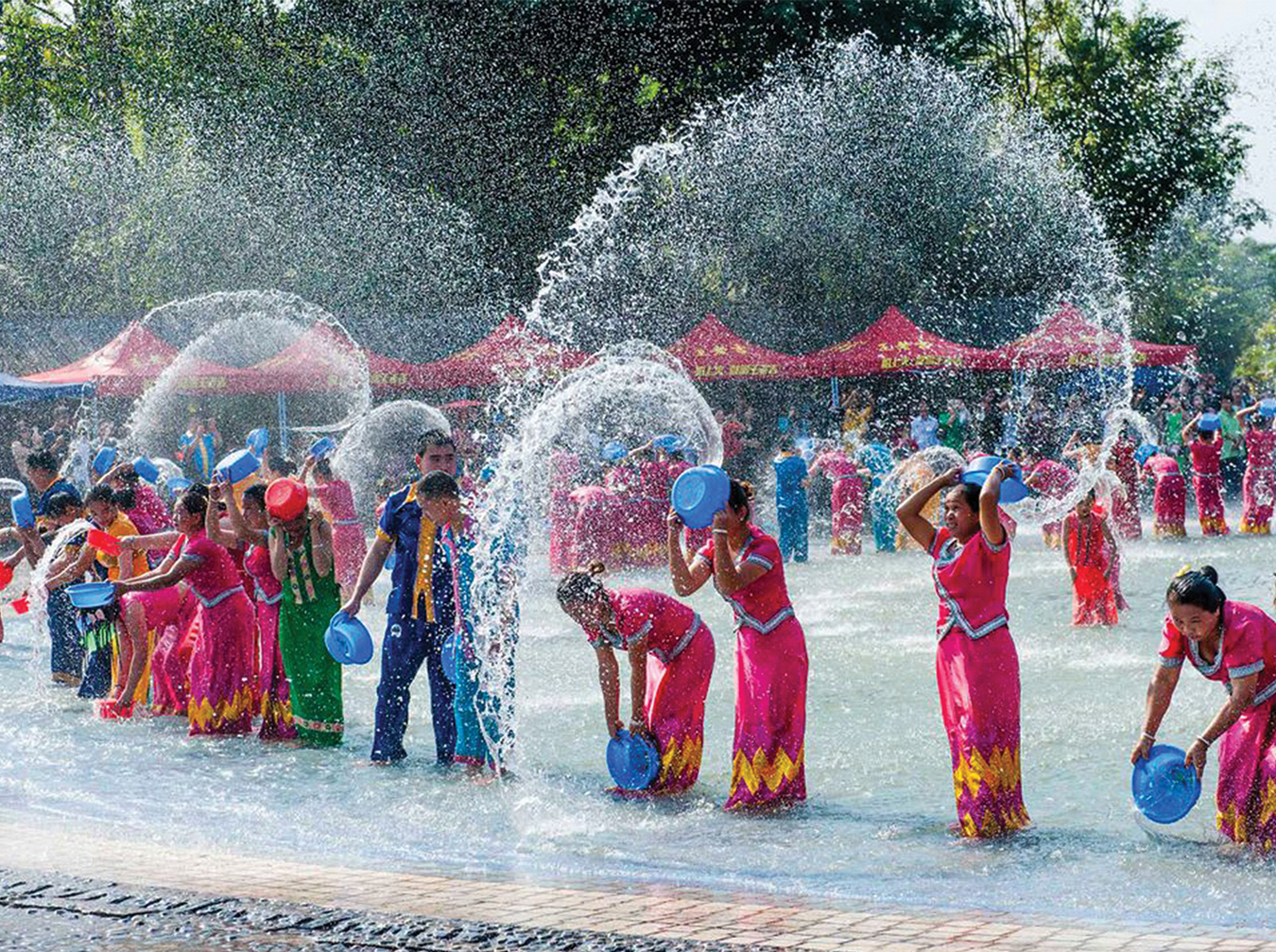
Thais believe water spiritually purifies and cleanses them of any bad luck or grievances from the past year
Best spots during Songkran
As the upcoming Songkran is the first major festival that would be held in Thailand since the beginning of the pandemic, there is a lot of excitement in the country about welcoming overseas tourists once again to this major event. With the resumption of flights from India, specially direct flights from many cities, TAT is keen to ensure a high footfall of Indian tourists during the period.
“For the Songkran festival the highlights are celebrations in many major tourists attraction in Thailand such as Bangkok, Pattaya, Phuket and Samui,” adds Sirisumpan.
Bangkok
Being the capital of Thailand, Bangkok is one of the best spots for tourists to enjoy during Songkran. The city has a wide variety of markets and restaurants for tourists to enjoy in. Both the foreigners and residents come together to celebrate the festival. Places like Silom, Khaosan Road, Phra Pradaeng District and Sanam Luang are crowded with people pouring water on each other. People who want traditional celebrations of Songkran combined with wild parties, for them, Bangkok is the city to head to.
Chiang Mai
For tourists looking to enjoy music and water fights, the hill town of Chiang Mai in northern Thailand is the ideal destination for them. The modern parts of the city have numerous shops and boutique hotels. Visitors can also rent vehicles to take them around the city to gain an overall experience of Songkran. Those seeking the blessings of Lord Buddha can worship at the Phra That Doi Suthep, one of the most sacred pilgrimage spots of Buddhism. Visitors can also shop in the local markets after Songkran and buy stylish hand made products at Thapae Walking Street. They can also visit the Queen Sirikit Botanical Garden and Rajapruek Royal and witness the beauty of various species of plants through their eyes.
“One of the famous places to celebrate Songkran in Thailand is the Northern region of Chiang Mai, where tourists would enjoy various facets of the festival from the traditional procession to water fun around the old town of Chiang Mai,” says Sirisumpan.
Phuket
The island located in Southern Thailand, heavily influenced by Chinese culture, is famous for its pristine beaches and is one of the go-to destinations for tourists during Songkran. There are more than 30 beaches on Thailand’s largest island. The main event of the city is the Phuket Water Festival when even the city police swap their service guns for water pistols and join in the friendly water gun battles. Phuket also offers exhibitions featuring local crafts and clothing along with processions of Phra Buddha Sihing around Patong Beach, a floral parade. Tourists wanting to enjoy a beautiful and quiet sunset can head to the Laem Phromthep viewpoint. Apart from the beaches the tourists can also enjoy classical architecture such as the Goom Restaurant and enjoy a delectable Chinese meal.
“Currently, we are in discussion with some of our travel trade partners on promoting Thailand but not specifically for the festival. Still, to keep the festive spirits alive, TAT will be organising some activities to celebrate Songkran Festival with our travel trade partners and with Indian tourists both online and offline,” says Sirisumpan.








